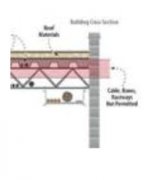May be in a bind on a install. Outdoor pavilion with tongue and grove finished ceiling, (2) 2x4 placed flat and stacked on each other, 3/4 wood decking on top of that, then roof tin. Lights and receptacles to be installed in tongue and grove ceiling, flush with ceiling finish. I can achieve the 1 1/2 clearance, but the concealment is what's tripping me up. Am I misinterpreting something, it first talks about exposed and concealed locations, then seem to disallow a concealed location altogether. Rigid seems to be a option, but again not concealed, and the exception doesn't specifically list a malleable iron box.
2020 NEC
2020 NEC



